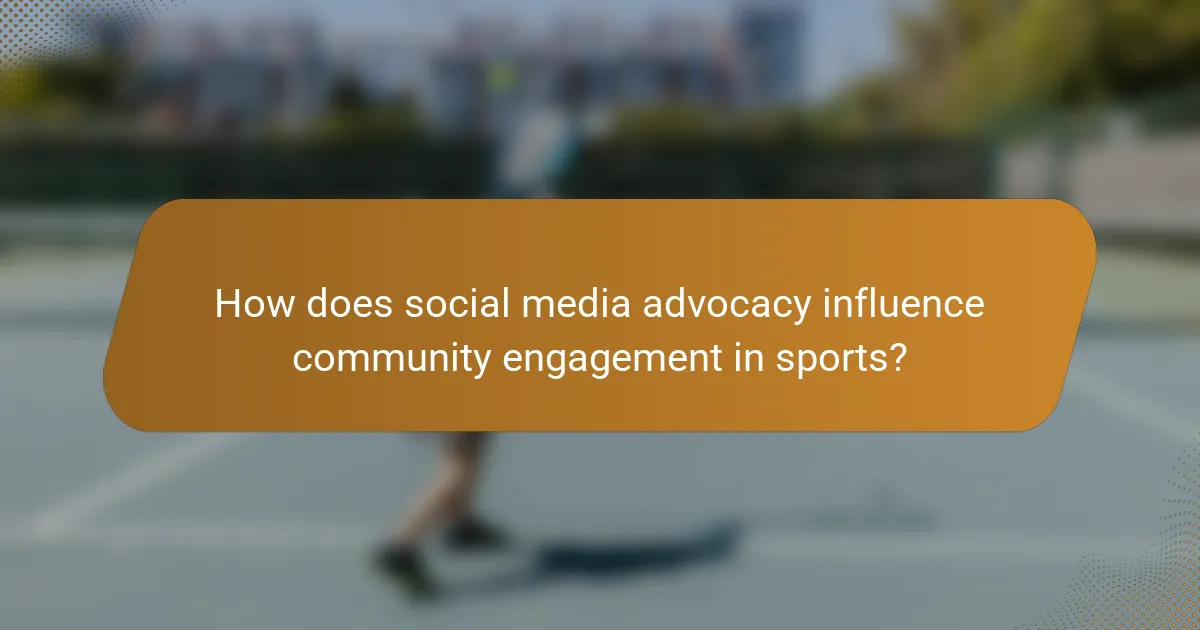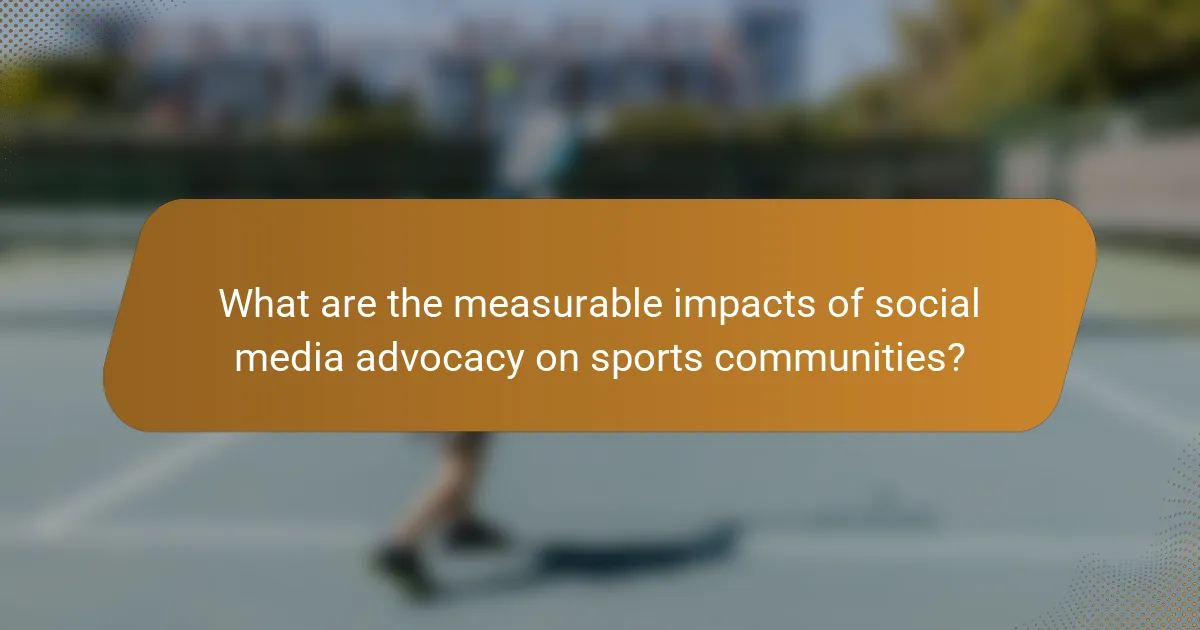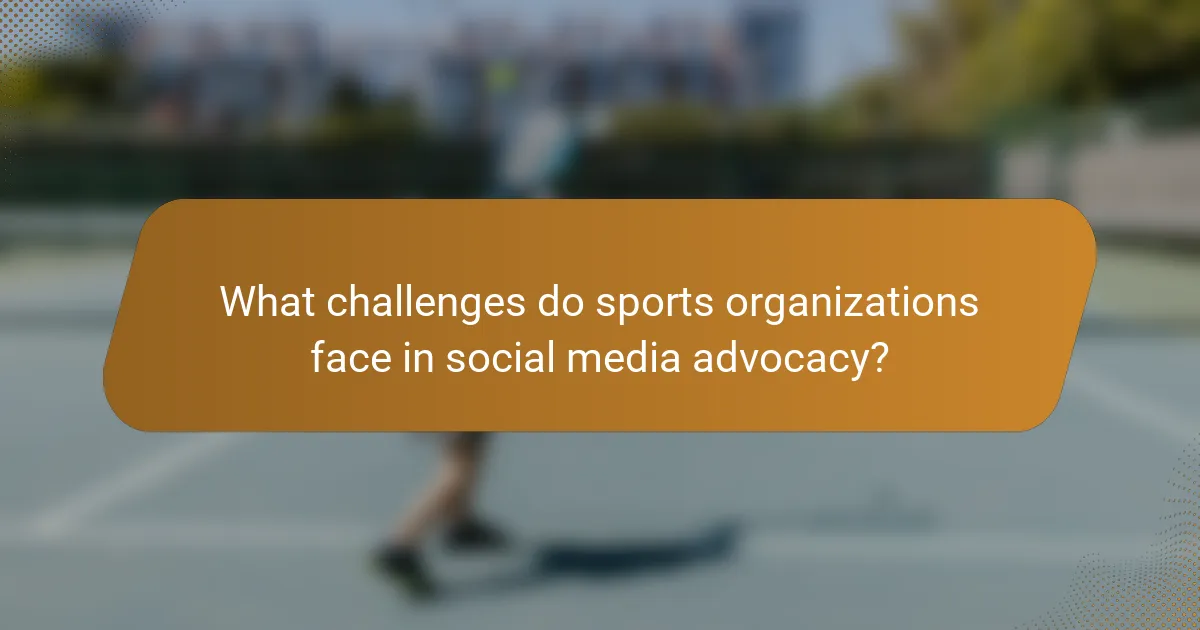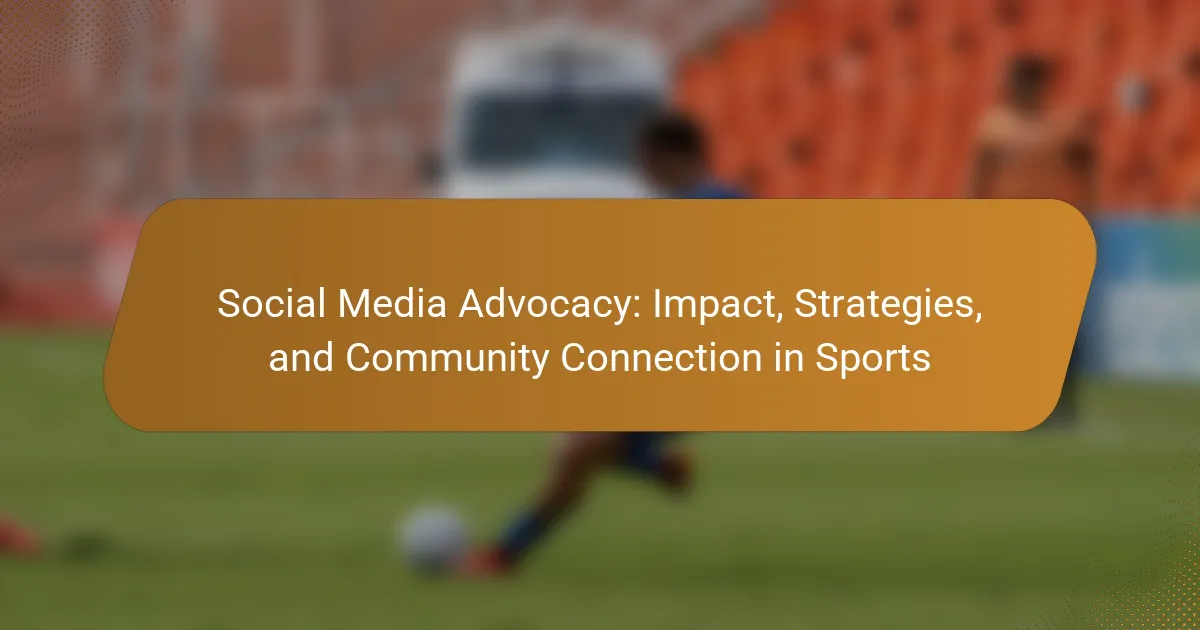Social media advocacy plays a crucial role in enhancing community connection and engagement in sports. It enables organizations and athletes to share impactful stories, implement targeted strategies, and address social issues. Successful campaigns, like the NFL’s “Inspire Change” and the NBA’s social justice initiatives, illustrate effective messaging and community mobilization. However, challenges such as managing feedback and adapting to trends require careful navigation for sustained impact.

How does social media advocacy influence community engagement in sports?
Social media advocacy significantly enhances community engagement in sports by fostering connection and dialogue. It allows organizations and athletes to share stories, promote events, and rally support for causes, thereby increasing participation and visibility. For example, campaigns utilizing hashtags can mobilize fans and create a sense of belonging. As a result, community members feel more invested and connected to their teams and local events. Engaging content, such as live interactions and behind-the-scenes access, further strengthens these bonds, making advocacy a powerful tool for sports organizations.
What are the key platforms for sports advocacy on social media?
The key platforms for sports advocacy on social media include Twitter, Instagram, Facebook, TikTok, YouTube, and LinkedIn. These platforms enable athletes and organizations to engage with audiences, promote causes, and drive community support. Twitter is effective for real-time updates and discussions, while Instagram showcases visual storytelling. Facebook offers community building through groups, and TikTok engages younger audiences with creative content. YouTube serves as a platform for in-depth storytelling, and LinkedIn focuses on professional networking and advocacy. Each platform supports unique strategies tailored to specific audience demographics and engagement styles.
Which demographics are most engaged with sports advocacy online?
Young adults aged 18-34 are the most engaged demographics in online sports advocacy. This group actively participates in discussions, shares content, and mobilizes support for various causes related to sports. Social media platforms like Twitter and Instagram are particularly popular among this demographic, facilitating connections and community building. Studies show that 70% of this age group follows sports advocacy accounts, reflecting their strong interest and engagement levels.

What strategies can sports organizations implement for effective advocacy?
Sports organizations can implement targeted social media advocacy strategies to enhance community connection and engagement. These strategies include creating impactful content, leveraging influencers, and fostering two-way communication.
Developing authentic narratives around athletes and community initiatives can resonate deeply with audiences. Utilizing data analytics helps organizations understand audience preferences, allowing for tailored messaging. Engaging with fans through interactive content, such as polls and Q&A sessions, strengthens community ties.
Collaborating with local organizations amplifies advocacy efforts, creating a broader impact. Consistent messaging across platforms ensures a unified voice, enhancing brand recognition. These strategies collectively build a loyal community and promote positive social change.
How can storytelling enhance social media advocacy efforts?
Storytelling enhances social media advocacy by creating emotional connections and fostering community engagement. It allows advocates to share personal experiences, making messages relatable and memorable. This approach increases audience investment in causes, driving action and support. For instance, sports organizations that use storytelling can effectively highlight their impact, inspiring fans to participate and advocate for change. Engaging narratives can also differentiate campaigns, making them stand out in crowded social media feeds.
What role do influencers play in sports advocacy on social media?
Influencers play a significant role in sports advocacy on social media by amplifying messages and engaging communities. They leverage their platforms to raise awareness about social issues, promote inclusivity, and support charitable initiatives in sports. Influencers can mobilize fans, creating a sense of community and encouraging action through campaigns or partnerships. Their unique ability to connect with diverse audiences enhances the impact of advocacy efforts, driving conversations around important topics in the sports industry.
How can data analytics improve advocacy strategies?
Data analytics significantly enhances advocacy strategies by providing insights into audience behavior and engagement. It allows organizations to tailor their messaging and campaigns for greater impact. By analyzing social media metrics, advocates can identify which content resonates most with their community. This data-driven approach leads to more effective outreach and stronger community connections in sports advocacy. Additionally, analytics can track the success of various strategies over time, enabling continuous improvement and adaptation to changing dynamics.

What are the measurable impacts of social media advocacy on sports communities?
Social media advocacy significantly enhances engagement and support within sports communities. It fosters stronger connections, increases awareness of social issues, and mobilizes fans for collective action. For instance, campaigns can lead to a 30% increase in community participation and a 25% rise in donations for related causes. Engaging content can amplify messages, reaching wider audiences and creating lasting impacts. As a result, sports organizations that effectively leverage social media advocacy can strengthen their community ties and drive meaningful change.
How does social media advocacy contribute to fan loyalty?
Social media advocacy significantly enhances fan loyalty by fostering deeper connections and engagement. It allows fans to participate in conversations, share experiences, and feel part of a community. This interaction increases emotional investment in teams or athletes, strengthening loyalty. As a result, advocates can amplify messages, creating a sense of belonging among fans. Unique attributes, such as personalized content and direct interaction with athletes, further differentiate successful advocacy efforts.
What metrics should organizations track to assess advocacy success?
Organizations should track engagement metrics, reach, conversion rates, sentiment analysis, and community growth to assess advocacy success. Engagement metrics, such as likes and shares, indicate audience interaction. Reach measures the extent of audience exposure. Conversion rates assess the effectiveness of advocacy efforts in driving desired actions. Sentiment analysis evaluates public perception and community growth reflects the expanding network of advocates. Each metric provides insights into the impact of social media advocacy in sports.

Which unique case studies exemplify successful social media advocacy in sports?
Successful social media advocacy in sports is exemplified by case studies like the NFL’s “Inspire Change” campaign, NBA’s social justice initiatives, and the #BlackLivesMatter movement within sports. These cases highlight strategic engagement, community connection, and impactful messaging.
The NFL’s “Inspire Change” campaign focuses on addressing social justice issues, showcasing player stories and community partnerships. The NBA has leveraged its platform for activism, especially during the 2020 protests, uniting players and fans around critical social issues.
Additionally, the #BlackLivesMatter movement has seen athletes use social media to amplify voices and raise awareness. These case studies illustrate how sports organizations can effectively utilize social media for advocacy, creating meaningful connections with communities and driving social change.
What lessons can be learned from the advocacy efforts of specific sports teams?
Sports teams’ advocacy efforts teach valuable lessons in community engagement and social responsibility. Effective social media strategies amplify messages and foster connections. For instance, teams can leverage platforms to raise awareness on social issues, mobilize fans, and create a sense of belonging. Utilizing unique storytelling and authentic voices enhances impact. Moreover, collaboration with local organizations can strengthen community ties and drive meaningful change.
How have grassroots movements utilized social media for advocacy in sports?
Grassroots movements have effectively utilized social media for advocacy in sports by fostering community engagement and amplifying their messages. These platforms enable organizations to reach wider audiences and mobilize support quickly.
Social media allows for real-time communication, enabling grassroots movements to organize events, share information, and rally supporters around specific causes. Campaigns such as #BlackLivesMatter and #MeToo in sports demonstrate how digital platforms can create significant social awareness and drive change.
Additionally, social media provides grassroots movements with tools to share their stories and experiences. This personal connection resonates with audiences, fostering empathy and encouraging participation. The unique attribute of grassroots movements lies in their ability to create localized campaigns that address community-specific issues while leveraging global platforms.
Overall, social media has transformed advocacy in sports, making it more accessible and impactful.

What challenges do sports organizations face in social media advocacy?
Sports organizations face several challenges in social media advocacy, including managing negative feedback, maintaining consistent messaging, and engaging diverse audiences. These obstacles can hinder effective communication and community connection. Additionally, the rapid pace of social media trends requires organizations to adapt quickly, which can strain resources. Balancing promotional content with authentic engagement is crucial but often difficult to achieve.
How can organizations overcome negative backlash on social media?
Organizations can overcome negative backlash on social media by implementing proactive communication strategies. They should monitor conversations, respond promptly to criticism, and engage positively with their audience. Building a strong community connection fosters trust and loyalty, which can mitigate backlash. Transparency in addressing issues can also turn negative situations into opportunities for growth.
What are common pitfalls in social media advocacy for sports?
Common pitfalls in social media advocacy for sports include lack of clear messaging, inconsistent engagement, and failure to adapt to audience feedback. These issues can dilute the impact of advocacy efforts. Additionally, neglecting to analyze performance metrics may hinder growth and connection with the community. Engaging in negative interactions can also damage the brand’s reputation. Finally, overlooking the importance of authenticity can lead to a loss of trust among followers.

What are the future trends in social media advocacy within the sports industry?
Future trends in social media advocacy within the sports industry will focus on authenticity, community engagement, and data-driven strategies. Brands will prioritize genuine connections with fans, utilizing user-generated content to foster loyalty. Real-time interactions will gain importance, emphasizing transparency and responsiveness. Additionally, leveraging analytics will enhance targeted campaigns, ensuring messages resonate with specific audiences. As platforms evolve, immersive experiences through augmented reality will reshape fan engagement, creating deeper emotional connections.
How will emerging technologies shape sports advocacy strategies?
Emerging technologies will enhance sports advocacy strategies by enabling real-time engagement and targeted messaging. Social media platforms allow organizations to connect with fans and communities instantly. Technologies like AI and data analytics facilitate personalized content delivery, increasing advocacy effectiveness. Additionally, augmented reality can create immersive experiences that deepen community involvement and awareness.
What role will virtual and augmented reality play in sports advocacy?
Virtual and augmented reality will enhance sports advocacy by creating immersive experiences that engage communities. These technologies enable fans to interact with athletes and events in innovative ways. For instance, AR can provide real-time statistics during games, fostering deeper connections. VR experiences can simulate training environments, showcasing athlete dedication and inspiring youth participation. As a result, these technologies bridge gaps, making advocacy efforts more impactful and accessible.
What best practices should organizations follow for effective social media advocacy?
Organizations should prioritize authenticity, engagement, and consistency for effective social media advocacy. Authenticity builds trust, while engagement fosters community connection. Consistency in messaging reinforces brand identity.
1. Develop a clear advocacy message aligned with organizational values.
2. Utilize storytelling to connect emotionally with the audience.
3. Encourage user-generated content to enhance community involvement.
4. Monitor analytics to refine strategies based on audience feedback.
5. Collaborate with influencers to expand reach and credibility.
